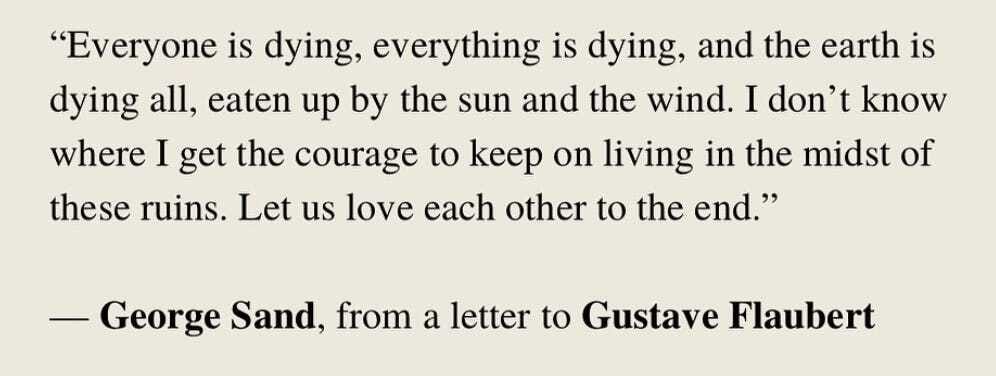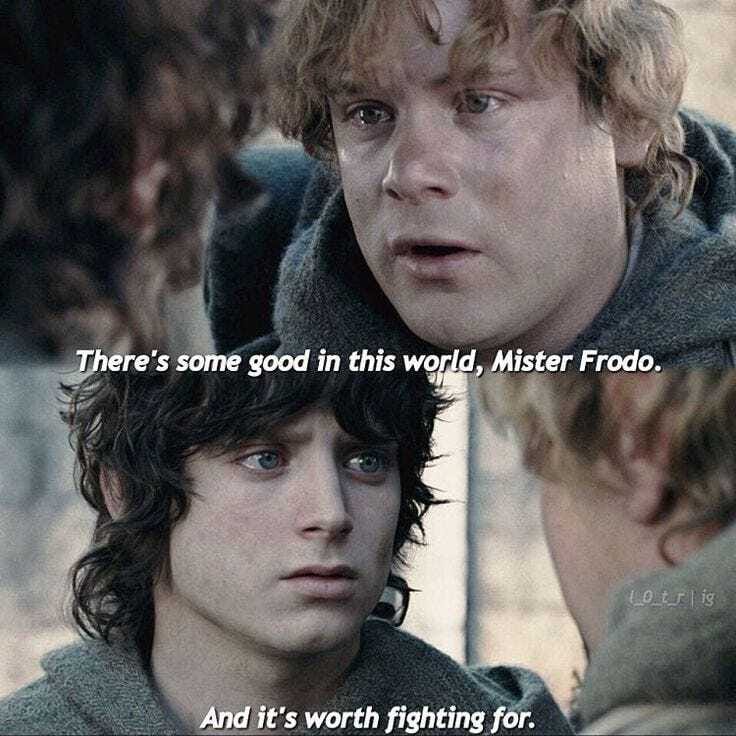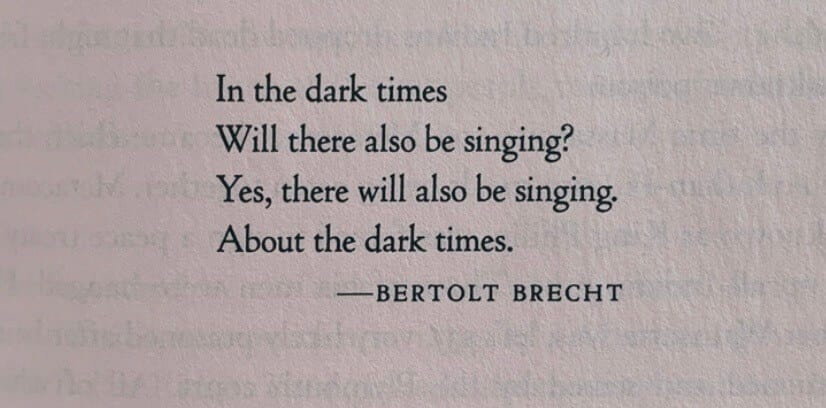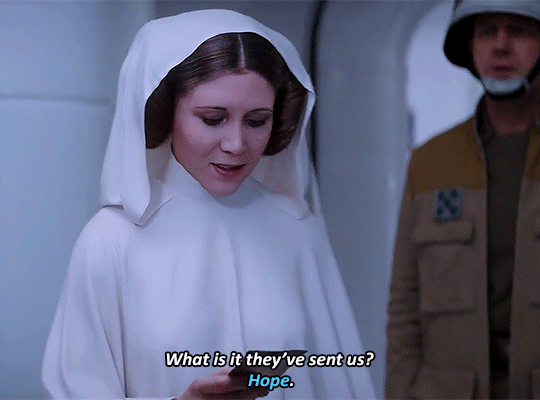- Creativity for Good
- Posts
- what we build on hope
what we build on hope
what does it mean to believe a better world is possible?
Back in February, I wrote about how everything I was writing seemed to be about grief.
It made a lot of sense at the time, given the general everything of the time — of which many of those everythings are still very much present, some of them even more so. So when I started drafting my second book this fall, I was expecting to be working along the same themes. I had one character grieving the loss of a relationship, and another grieving an impending loss that felt (to them) inescapable. Of course this would be another grief book, right?
But as the book has taken shape, as often happens, the story shifted its energy, and I found myself writing perhaps the most stubbornly hopeful piece of fiction I’ve ever created. My two beloved, grieving characters have shown themselves to be full of a furious, determined resilience — one of them deeply tempted towards death but forcing herself to stay alive, the other desperate to live every moment they can get, refusing to resign themself to the fate someone else mapped out for them.
It’s not hopeful in a sweet, optimistic sort of way. It’s hopeful in a way that is stubborn. It’s bitter and purposeful, drag-me-out-by-the-fingernails determined. It’s I will do this, and you can’t stop me. It’s I refuse to let what is be all that can be.
It’s not at all the book I expected to be writing. But it is absolutely the book I need.

When we’re young, hope is an unstructured, amorphous, absent-minded sort of thing. We hope that people will like us, that we might get a birthday present, that we’ll grow up to be safe and healthy and loved. It’s not, as it is for so many adults, something cultivated and intentional, something that takes work.
And oh, it takes work these, days, doesn’t it?
One of my favorite writers on the topic of hope is Mariame Kaba, who — with fellow activist and organizer Kelly Hayes — wrote Let This Radicalize You, one of my favorite books on channeling grief and anger into action. In another co-written piece, Kaba and Hayes write, “When we talk about hope in these times, we are not prescribing optimism. Rather, we are talking about a practice and a discipline.” They compare this to “Active Hope,” a concept outlined in the book of the same name by Joanna Macy and Chris Johnstone:
Active Hope is a practice. Like tai chi or gardening, it is something we do rather than have […] Since Active Hope doesn’t require our optimism, we can apply it even in areas where we feel hopeless. The guiding impetus is intention; we choose what we aim to bring about, act for, or express. Rather than weighing our chances and proceeding only when we feel hopeful, we focus on our intention and let it be our guide.

Looking back at my own writing, over the past few years but especially over the past several months, I’ve found that while the pages are full of grief, they’re also, inexplicably, full of hope. Malkia Devich-Cyril, writing on intergenerational trauma, death, and grief in movement-building, writes, “Grief is the opposite of indifference. Grief is an evolutionary indicator of love — the kind of great love that guides revolutionaries.” Kaba and Hayes take this a step further: “Hope, too, requires us to reject indifference. And like any indifference-rejecting phenomenon, it demands effort in order to thrive.”
They continue,
This practice of hope allows us to remain creative and strategic. It does not require us to deny the severity of our situation or detract from our practice of grief. To practice active hope, we do not need to believe that everything will work out in the end. We need only decide who we are choosing to be and how we are choosing to function in relation to the outcome we desire, and abide by what those decisions demand of us.
Hope, then, is an act of creation, as much as it is an act of discipline, a meditative practice, a way of disrupting the status quo. Hope is not the opposite of grief, but rather, one of its most stubborn expressions.
One of the places this gets lost, I think, is that the mainstream narratives we have around grief are problematic at best and deeply damaging at worst. When we think about grief, we think about outward reactions: weeping, raging, catatonia, stagnation. These are expressions of grief, but they’re instinctive, unthinking, and — if left unattended — a pathway to despair. There are only so many tears we can cry before we’re dehydrated and need to drink something, only so much time we can sit in catatonia before we need to bathe and change into clean clothing.
There is a difference between sitting in grief and being with grief. Sitting in grief, for too long and with no movement, is a recipe for despair. Being with grief — not just feeling it, but listening to it, connecting to it, giving it space to share what it needs you to know — is a heady, heart-opening, sometimes overwhelming practice, but it’s one that brings us forward. It encourages action, and growth. It’s an opening to hope.
After the election, I wrote about the unexpected optimism I was feeling after the results came in. I wrote about creation as an antidote to despair, and I still believe that’s true.
Creativity is an inherently hopeful act. The very act of making something is hopeful, because by making something — whether it’s a meal or a poem, a photo or a sweater, a novel or a garden — we’re crafting a tiny piece of the world we want to believe in. A world we want to make possible. Each piece of beauty we put into the universe is our way of saying, yes, but, what if?

My classics-loving father would probably cringe at my saying this, but these days, Rogue One is my favorite Star Wars movie. In my opinion, it’s the most hopeful of all of the films. Sure, it ends with all the main characters dying, but it also has one of my favorite series of call-to-arms speeches, possibly only rivaling Sam’s “that there’s some good in this world, Mr. Frodo” in The Two Towers — because, to me, it’s one of the best fictional allegories to that lovely bit of Talmud about planting seeds for trees whose fruit you’ll never get to eat, because it’s not for you. It’s for the greater good. It’s for everyone.
“We’ll take the next chance. And the next chance, and the next, until we win — or until all the chances are spent.”
“You’re asking us to invade an imperial installation based on nothing but hope.”
“Rebellions are built on hope.”
Engaging in hope as a discipline is about playing the long game. These movements —for reproductive justice, for abolition, for the dismantling of systems of white supremacy and patriarchy and institutionalized harm — are not doing this work under the assumption that their visions will be realized in our lifetime. Rather, they’re fueled by the understanding that building a liberated world is work worth doing, even if we’ll never see the results.
Creating, engaging in creativity, doing creative work — all of these are acts of hope. We’re making something that didn’t exist before, even if we don’t know where it will ultimately land, what its ultimate impact might be. We don’t know if the meal we’re cooking will someday hold a memory that someone looks for comfort to in times of worry or pain or grief, if the sweater we’ve knitted will become someone’s favorite source of warmth, if the poem or essay or novel we’re writing will open someone’s eyes to something they never thought of before, offer a question that changes someone’s path, becomes a way for someone to explore who they are, what they’re doing, or where they want to go in the world. We don’t know, but we make things anyway.
We keep creating, because we believe, we hope, that it will matter.
And under capitalism, under white supremacy, under the systems that do their damndest to make sure we feel like nothing we can do will make a difference, what is more rebellious than that?

questions on creating for good
How do you think about the relationship between hope and grief?
Do they exist together? Separately? How are they connected? What do they have in common? What do you associate with them? What comes up for you around hope and grief — separately or together — when you think about the issues you care about?
What does hope look like for you, and where does it show up in your work?
What comes to mind when you think about hope? Do you think of your creative work as hopeful? Why or why not?
What do you think of the idea of creativity as an expression of hope?
What would incorporating this concept in your creative process mean to you? What might it change? How might it change the way you approach your creative work? The way you share it with others?
And maybe most importantly: How do you think about hope?
resources, links, and further reading
spotlight on: hope
read:
“Hope is…” (my very favorite example of Tumblr’s ‘yes, and’ culture)
“Hope Is a Practice and a Discipline: Building a Path to a Counterculture of Care” (Kelly Hayes and Mariame Kaba for NonProfit Quarterly)
“Don’t Tell Me to Despair About the Climate: Hope Is a Right We Must Protect” (Morgan Florsheim for Yes! Magazine)
“A Left-Handed Commencement Address” (Ursula K. Le Guin at Mills College)
watch:
listen:
“Organized Grief = Social Movements” (Malika Devich-Cyril on the “It’s OK That You’re Not Ok” podcast)
“A History of Saving the World” (Ada Palmer on the “Hope is a Verb” podcast)
donate:
MediaJusticeMediaJustice (formerly Center for Media Justice) is building a powerful grassroots movement for a more just and participatory media —fighting for racial, economic, and gender justice in a digital age. Launched in 2009 by Malkia Devich Cyril, Amy Sonnie, and Jen Soriano — MediaJustice boldly advances communication rights, access, and power for communities harmed by persistent dehumanization, discrimination and disadvantage. Home of the MediaJustice Network, we envision a future where everyone has sustained and universal access to open and democratic media and technology platforms.